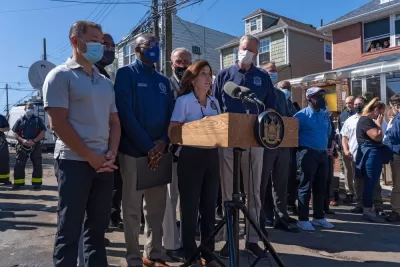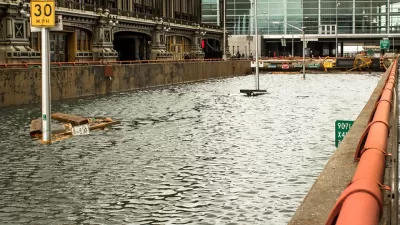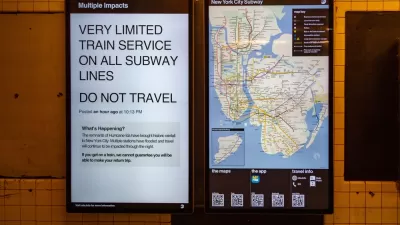Basement apartments were the least safe place to be as the remnants of Hurricane Ida sent floodwaters ripping through the Northeast.

Now that the water has receded and the Northeast is taking stock of the costs—human and economic—from the historic flooding that followed as the remnants of Hurricane Ida ripped through the northeast, basement apartments have been identified as a primary source of deadly risk throughout the storm.
Much of the media focus in the wake of Ida in northeast is focusing on illegal basement apartments—a huge source of housing for low-income communities in around New York City. "Cramped basement apartments have long been a prevalent piece of New York City’s vast housing stock, a shadowy network of illegal rentals that often lack basic safety features like more than one way to get out, and that yet are a vital source of shelter for many immigrants," write Mihir Zaveri, Matthew Haag, Adam Playford, and Nate Schweber for The New York Times.
As of the writing of the New York Times article, 11 of the 13 people killed during Ida in New York City died in a basement apartment—as many as had died in the state of Louisiana (again, at the time of the writing).
The public health and safety risks of basement apartments are well documented, according to the article, regarding fires or carbon monoxide poisoning. Climate change introduces a new risk, however: "the likelihood of deadly flooding, when a wall of water blocks what is often the only means of escape."
Building and safety regulations had trouble keeping up with basement apartments before extreme weather scrambled risk in the United States. The city had received 157,000 complaiints about illegal basement apartment conversions in 2021 leading up the tragic arrival of Ida to New York. "The law governing these apartments is complex, and includes rules that say a basement’s ceilings must be at least 7 feet 6 inches high and that living spaces must have a window. The city must approve apartments with a certificate of occupancy before they can be rented."
The article includes testimony from residents of basement apartments—including some who lived through potentially fatal flooding.
FULL STORY: How the Storm Turned Basement Apartments Into Death Traps

Planetizen Federal Action Tracker
A weekly monitor of how Trump’s orders and actions are impacting planners and planning in America.

Restaurant Patios Were a Pandemic Win — Why Were They so Hard to Keep?
Social distancing requirements and changes in travel patterns prompted cities to pilot new uses for street and sidewalk space. Then it got complicated.

Map: Where Senate Republicans Want to Sell Your Public Lands
For public land advocates, the Senate Republicans’ proposal to sell millions of acres of public land in the West is “the biggest fight of their careers.”

Maui's Vacation Rental Debate Turns Ugly
Verbal attacks, misinformation campaigns and fistfights plague a high-stakes debate to convert thousands of vacation rentals into long-term housing.

San Francisco Suspends Traffic Calming Amidst Record Deaths
Citing “a challenging fiscal landscape,” the city will cease the program on the heels of 42 traffic deaths, including 24 pedestrians.

California Homeless Arrests, Citations Spike After Ruling
An investigation reveals that anti-homeless actions increased up to 500% after Grants Pass v. Johnson — even in cities claiming no policy change.
Urban Design for Planners 1: Software Tools
This six-course series explores essential urban design concepts using open source software and equips planners with the tools they need to participate fully in the urban design process.
Planning for Universal Design
Learn the tools for implementing Universal Design in planning regulations.
Heyer Gruel & Associates PA
JM Goldson LLC
Custer County Colorado
City of Camden Redevelopment Agency
City of Astoria
Transportation Research & Education Center (TREC) at Portland State University
Camden Redevelopment Agency
City of Claremont
Municipality of Princeton (NJ)





























